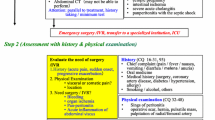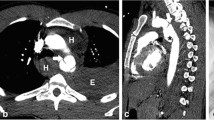Abstract
Background
Evaluation of blunt abdominal trauma is controversial. Computed tomography (CT) of the abdomen is commonly used but has limitations, especially in excluding hollow viscus injury in the presence of solid organ injury. To determine whether CT reports alone could be used to direct operative treatment in abdominal trauma, this study was undertaken.
Methods
The trauma database at Auckland City Hospital was accessed for patients who had abdominal CT and subsequent laparotomy during a five-year period. The CT scans were reevaluated by a consultant radiologist who was blinded to operative findings. The CT findings were correlated with the operative findings.
Results
Between January 2002 and December 2007, 1,250 patients were evaluated for blunt abdominal injury with CT. A subset of 78 patients underwent laparotomy, and this formed the study group. The sensitivity and specificity of CT scan in predicting hollow viscus injury was 55.33 and 92.06 % respectively. The positive and negative predictive values were 61.53 and 89.23 % respectively. Presence of free fluid in CT scan was sensitive in diagnosing hollow viscus injury (90 %). Specific findings for hollow viscus injuries on CT scan were free intraperitoneal air (93 %), retroperitoneal air (100 %), oral contrast extravasation (100 %), bowel wall defect (98 %), patchy bowel enhancement (97 %), and mesenteric abnormality (94 %).
Conclusions
CT alone cannot be used as a screening tool for hollow viscus injury. The decision to operate in hollow viscus injury has to be based on mechanism of injury and clinical findings together with radiological evidence.
Similar content being viewed by others
References
Watts DD, Fakhry SM (2003) Incidence of hollow viscus injury in blunt trauma: an analysis from 275,557 trauma admissions from the EAST Multi-Institutional Trial. J Trauma 54:289–294
Fakhry SM, Watts DD, Luchette FA (2003) Current diagnostic approaches lack sensitivity in the diagnosis of perforated blunt small bowel injury: analysis from 275,557 trauma admissions from the EAST Multi-Institutional HVI data. J Trauma 54:295–306
Fakhry SM, Brownstein M, Baker CC et al (1999) Relatively short diagnostic delays produce morbidity and mortality in blunt small bowel injury (SBI): an analysis of time to operative intervention in 202 patients from a multicentre experience. J Trauma 47(1):207
Miller LA, Shanmuganathan K (2009) Multidetector CT evaluation of abdominal trauma. Radiol Clin N Am 43:1079–1095
Brofman N, Atri M, Hanson JM et al (2006) Evaluation of bowel and mesenteric blunt trauma with multi-detector CT. Radiographics 26:1119–1131
King M, Paice R, Civil ID (1996) Trauma data collection using a customised trauma registry: a New Zealand experience. N Z Med J 109(1023):207–209
Hanks PW, Brody JM (2003) Blunt injury to mesentery and small bowel: CT evaluation. Radiol Clin N Am 41:1171–1182
Donohue JH, Federle MP, Griffiths BG (2987) Computed tomography in the diagnosis of blunt intestinal and mesenteric injuries. J Trauma 27:11–17
Killeen KL, Shanmuganathan K, Poletti PA (2001) Helical computed tomography of bowel and mesenteric injuries. J Trauma 51:26–36
Hamilton P, Rizoli S, McLellan B et al (1995) Significance of intra-abdominal extra-luminal air detected by CT scan in blunt abdominal trauma. J Trauma 39(2):331–333
Brody JM, Leighton DB, Murphy BL et al (2000) CT of blunt trauma bowel and mesenteric injury: typical findings and pitfalls in diagnosis. Radiographics 20:1525–1536
Yegiyants S, Abou-Lahoud G, Taylor E (2006) The management of blunt abdominal trauma patients with computed tomography scan findings of free peritoneal fluid and no evidence of solid-organ injury. Am Surg 72:943–946
Rodriguez C, Barone JE, Wilbanks TO et al (2002) Isolated free fluid on computed tomographic scan in blunt abdominal trauma: a systematic review of incidence and management. J Trauma 53:79–85
Ng AKT, Simons RK, Torreggiani WC et al (2002) Intra-abdominal free fluid without solid-organ injury in blunt abdominal trauma: an indication for laparotomy. J Trauma 52:1134–1140
Sherck JP, Oakes DD (2009) Intestinal injuries missed by computed tomography. J Trauma 30:1–5
Author information
Authors and Affiliations
Corresponding author
Rights and permissions
About this article
Cite this article
Bhagvan, S., Turai, M., Holden, A. et al. Predicting Hollow Viscus Injury in Blunt Abdominal Trauma with Computed Tomography. World J Surg 37, 123–126 (2013). https://doi.org/10.1007/s00268-012-1798-3
Published:
Issue Date:
DOI: https://doi.org/10.1007/s00268-012-1798-3




